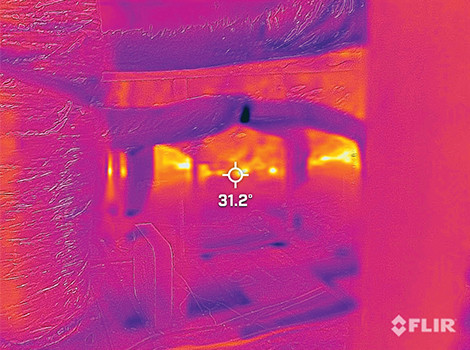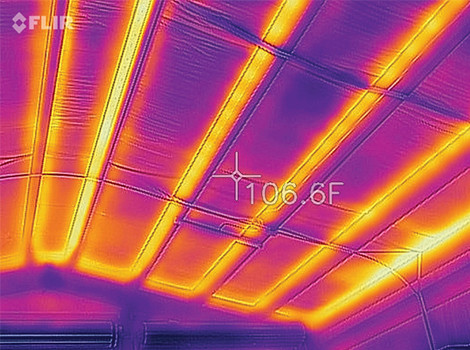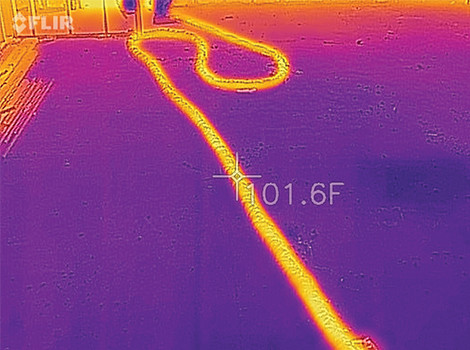The Visible Spectrum


Spray Foam Magazine – Summer Issue 2022 – Could infrared imagery be proven to be part of the solution to help homes achieve energy efficiency through the application of SPF?
Across the industry, there is an increasing amount of spray foam contractors using infrared cameras. We spoke to Jimmy Flex, owner of CCSI Spray Foam Insulation to see why he uses this technology on the job.
Infrared, also referred to as IR, is a type of electromagnetic radiation that is not visible but can be felt as heat. The hotter an object is, the more infrared radiation it gives off as an electronic signal, which is then used to generate an image.
Even though many see thermal imaging as a recent discovery, the concept of infrared radiation has been around since 1800 when British astronomer Sir William Herschel completed an experiment involving direct sunlight through a prism. He placed a thermometer outside the red end of the visible spectrum and noted that the temperature was markedly high. Thus, he discovered infrared radiation causes the bonds between molecules to move and release energy that is felt as heat.
The actual ability to capture that image has been around since 1929, when Hungarian physicist Kalman Tihanyi invented the first infrared-sensitive camera for the British army to use as anti-aircraft operations following World War I.

The bright yellow spots indicate excess heat in an attic space–a definite temperature change, which indicated to the contractor the area of concern around the perimeter of the house.
Spectrometers are a scientific instrument that help conclude information about an object or substance through the analysis of its light properties. Today, these instruments have much higher resolution and a faster response, but the fundamentals are the same as Herschel’s original discovery. However, the detector today is much smaller and faster than a mercury thermometer. After digesting all the history behind the science, what we really want to know is why spray foam contractors are increasingly using these cameras. Jimmy Flex helps explain by using a recent project as an example of how his infrared camera helped him and his client solve a humidity issue and prove that SPF really does the job intended.
The project is based in Dickinson, TX. Galveston County. The CCSI Spray Foam crew received a referral call for people who had just bought a home that was foamed by another company and was having humidity issues. Flex clarified, “The client called and said he purchased a foamed house, but he was having higher electricity bills and humidity compared to what he thought he should have. The house was a retrofit with updated HVAC, but they left the blown-in insulation. Upon inspection, we could see areas allowing air to infiltrate the attic and areas where the foam was only 2-3” thick and not up to code or standards for our climate zone.”

thermal imaging camera can be used to show customers thermal bridging, which is a big issue with fiberglass since it compresses between purlins and a metal roof.
The previous contractor left huge voids and to identify precisely where they were, the crew packed their thermal camera and sought to locate them. Heading to the home, the crew also had their Graco E30 Reactor 2 Elite proportioner. Before starting work, they suited up in their Tyvek suits, put on their 3M full face masks, 6 mil gloves and spray socks. Their FLIR ONE Pro camera, which they recently upgraded to, has better picture quality, more options in the app, and it can be attached to a cell phone. The crew was now ready to investigate. Flex recalls his first IR camera stating, “Years ago when I got out of college, we had a huge bulky FLIR we would use to find water damage. They were $3,000 and it took extra steps to get pics to your laptop. The iPhone has changed the game. Prices are affordable so there’s no excuse not to get one. Contractors could totally use one of these cameras to their advantage.”
The CCSI Spray Foam crew used their FLIR ONE Pro and discovered that the previous foam applied didn’t extend to the wall header, allowing heat and the Gulf of Mexico humidity to pour into the attic. This camera has a 160 x 120-pixel thermal sensor that can measure surface temperature from -20˚C to 400˚C with ±3˚C accuracy and thermal sensitivity of 150mK, allowing temperature differences of just 0.15˚C to be shown on screen. It has a 55˚ x 43˚ field of view which enables the user to capture a large area in a single shot. It is possible to use photo, video, and time-lapse modes to capture intermittent faults and monitor temperature patterns over a longer period or process, as well as taking instant snapshots. When the crew found the evidence of the voids, they knew they needed to remove the blown-in insulation before they proceeded to apply the new foam to standard.
Using Accufoam by Creative Polymers, Flex said, “As an owner, I like the yield and my employees like the ease of spraying this foam and the support they get from Creative Polymers. We used one set of foam spraying 5.5-6 inches.” The crew sealed all the voids, and the customer was so happy with the results, he asked the CCSI Spray Foam crew to come back and spray his new garage when it’s completed.
Jimmy Flex uses his thermal image camera on his cellphone on most jobs because it makes it easier to sell to his clients on the effectiveness of foam with before and after pics. It also shows them where a problem is without guesswork. Flex said, “It really separates us from the average guy who is just giving out prices. I like to explain why we quote a certain thickness, certain application and show what kind of results other people have had in the area. It seems building science has been lost in the business practices of many companies. We tend to fix other people’s work more. The FLIR ONE Pro basically helps us show the homeowner why.”

A thermal imaging camera can also be used to ensure an SPF hose is heating up correctly.
Thermal imaging-based energy efficiency is yet another way to help prove to clients that SPF does a great job at making the home energy efficient, and with these high-tech thermal imaging cameras, the client can see the results of the foam in the home.
Sidenote: Please be aware that there are many IR cameras on the market. Do your research and see what works best for your company.
Disqus website name not provided.




































